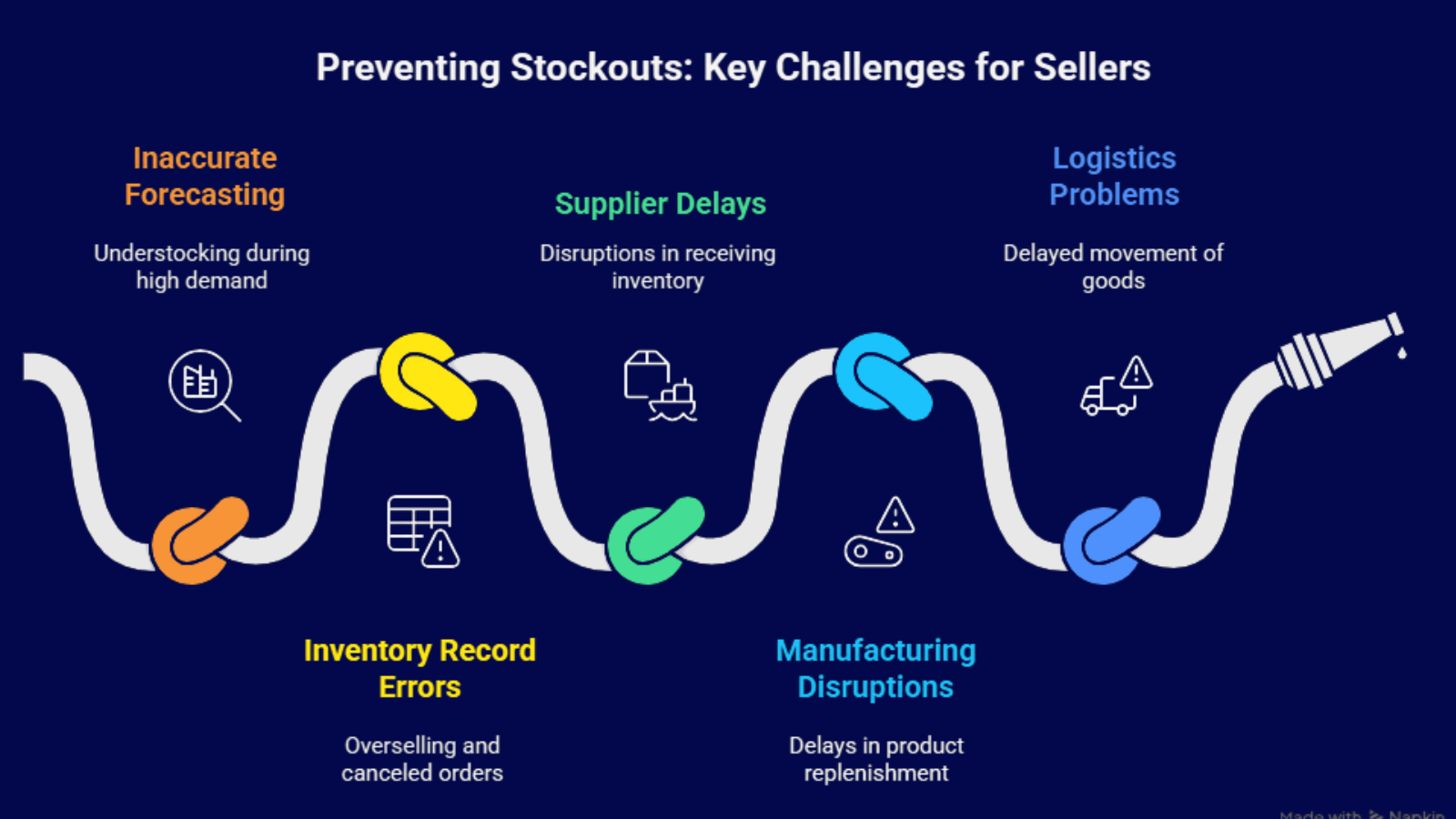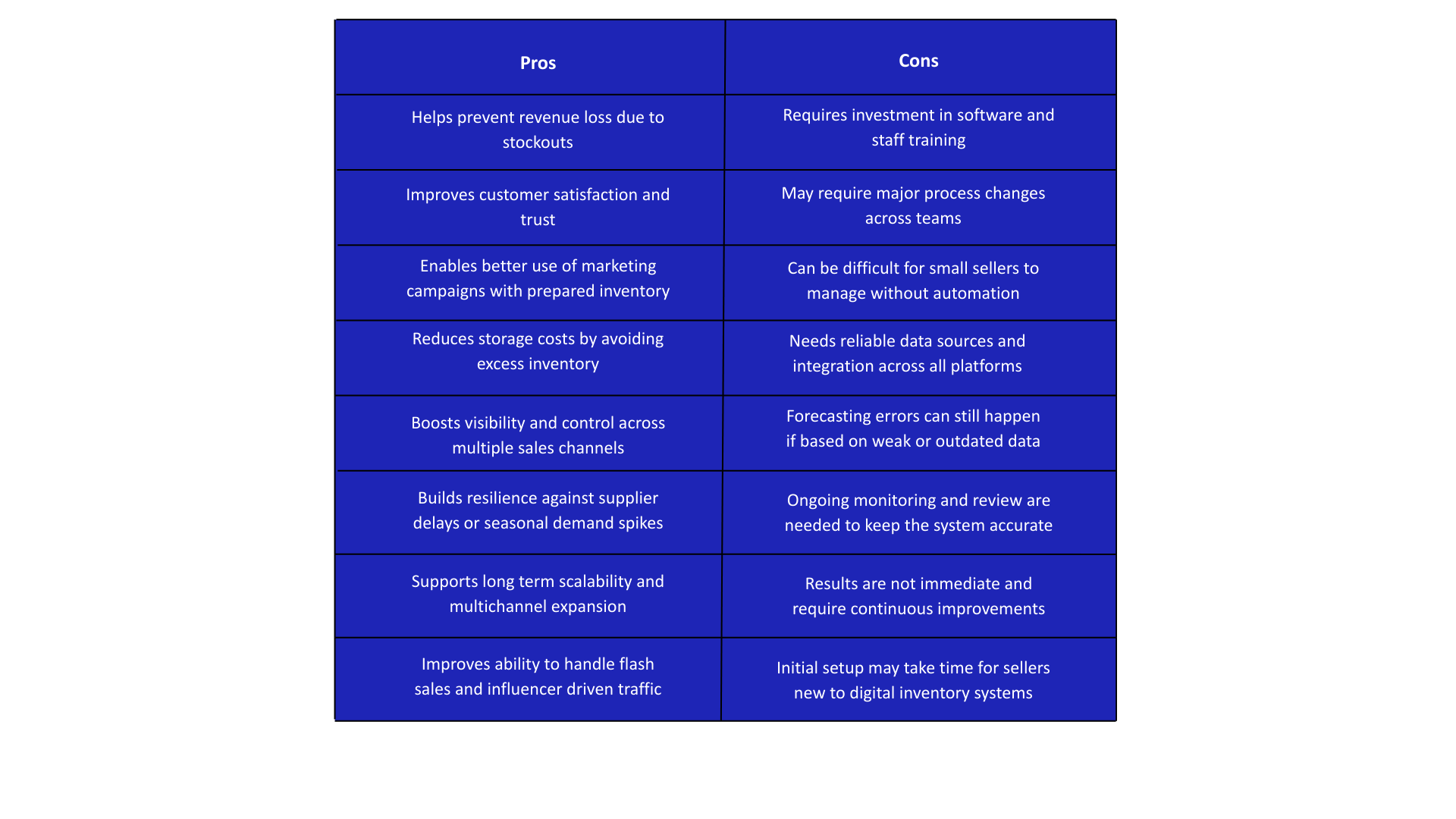
In India’s fast-paced retail and ecommerce landscape, sellers constantly walk a fine line between stockouts and overstock, and the consequences of missteps are costly. A stockout means missed sales, lower platform rankings, and frustrated customers who may never return.
Overstock, on the other hand, ties up working capital, increases warehousing costs, and leads to markdowns or dead inventory. With unpredictable demand driven by regional festivals, flash sales, and fast-changing trends, relying on guesswork or manual tracking is no longer sustainable for growth-focused sellers.
To succeed on platforms like Amazon India, Flipkart, Meesho, or even in digitally enabled Kirana stores, sellers need to shift from reactive to proactive inventory control. This requires a strategy heavy and data driven mindset that brings together accurate forecasting, agile demand planning, and smart safety stock management. When done right, smart inventory planning helps sellers reduce risks, meet customer demand consistently, improve profitability, and scale their operations across multiple channels with confidence.
What Is a Stockout?

For sellers, a stockout is one of the most frustrating and costly challenges in business. A stockout happens when you run out of a product and cannot fulfill customer orders due to lack of available inventory. This can lead to immediate revenue loss, poor customer experience, lower product rankings on ecommerce platforms, and in some cases, negative reviews or permanent customer loss.
Unlike overstock, where unsold products sit idle and increase storage costs, stockouts represent missed opportunities. They send a message to the customer that the business is not prepared, even when demand is high. For sellers in India, especially those dealing with unpredictable sales cycles, seasonal surges, or intense competition across marketplaces like Amazon India, Flipkart, or their own direct to consumer store, stockouts can slow down growth and damage customer relationships.
When a stockout occurs, sellers should act quickly. First, update the product status across all selling platforms to avoid accidental purchases. If a customer has already placed an order for an item that is out of stock, communicate clearly and honestly. Offer alternatives, refunds, or the option to wait for restocking. Wherever possible, provide a realistic restock date. Customers appreciate transparency and are more likely to return if their expectations are managed well.
Five Common Causes of Stockouts That Sellers Face
Even experienced sellers can run into stockouts, especially in a market as fast moving and complex as India’s. Here are the most common causes and what to watch for:

1. Inaccurate Forecasting
Many sellers rely on assumptions or basic sales averages, but this often leads to understocking during periods of high demand. Inaccurate forecasting, especially around festivals, sale events, or trending products, can cause popular items to sell out quickly. Without access to data based forecasting tools or insights into changing customer behavior, sellers may struggle to predict how much stock is actually needed.
2. Inventory Record Errors
Manual inventory tracking, spreadsheet based systems, or delayed updates between online and offline sales channels can cause serious errors. Sellers may believe they have products in stock when they do not, leading to overselling and canceled orders. These problems are common for sellers managing inventory across multiple platforms without a unified inventory management system.
3. Supplier Delays
For sellers who depend on third party suppliers or import products, any delay in receiving inventory can result in stockouts. Shipping congestion, customs delays, raw material shortages, or supply chain disruptions on the supplier’s side all contribute to this risk. Sellers with limited supplier options or long lead times are especially vulnerable.
4. Manufacturing Disruptions
If you produce or assemble your products, any issue in manufacturing can disrupt your ability to maintain stock. Labor shortages, machine breakdowns, low production capacity, or poor coordination with vendors can all delay replenishment. These disruptions are especially damaging during high traffic periods when every day of downtime equals missed sales.
5. Logistics and Delivery Problems
Stockouts are not always caused by a lack of inventory. Sometimes the issue is delayed movement of goods. If shipments are stuck in transit, delayed at fulfillment centers, or affected by poor last mile delivery, your listings can show out of stock even if products are physically available. For sellers delivering across India, weather issues, transport breakdowns, and regional delivery gaps can all impact availability.
Why Smart Inventory Planning Matters?
The cost of stockouts in India is staggering. When customers cannot find what they are looking for, it impacts both immediate sales and long-term brand loyalty. Studies show that up to 43 percent of Indian consumers will switch to another brand when faced with an out of stock product. This leads to lost revenue, poor customer experience, and lower platform rankings. On the other side, overstock ties up working capital, increases storage expenses, and often results in dead inventory that must be discounted, further cutting into profits.
For Indian sellers operating in categories like fast moving consumer goods, seasonal fashion, electronics, or home essentials, smart inventory planning is no longer optional. Success depends on having a clear, data driven strategy that addresses all the major inventory challenges. The most effective approach includes:

- Accurate forecasting – using historical sales data, seasonality, and trends to predict demand with precision
- Agile demand planning – adjusting supply and inventory decisions based on real time market changes and cross functional inputs
- Calculated safety stock – keeping just enough buffer inventory to handle unexpected delays or demand spikes without tying up excess capital
Together, these practices help sellers optimize stock levels, avoid costly mistakes, and meet customer expectations across all channels.
18 Effective Ways Sellers Can Prevent Stockouts
Stockouts hurt sales, damage customer trust, and lower your chances of winning repeat business. While causes like inaccurate forecasting, delayed shipments, or supplier issues are common, sellers can reduce the risk with a proactive inventory strategy.
Below are 18 practical ways to prevent stockouts, explained with use cases that apply to Indian sellers working across ecommerce platforms, physical stores, and direct to consumer websites.
1. Improve Inventory Accuracy
Many sellers face stockouts simply because they do not have an accurate picture of what is available. Manual stock entries, outdated spreadsheets, and unsynced inventory across channels can lead to missed items or overselling.
Use Case: A seller on Flipkart and Amazon updates stock levels manually at the end of each day. By the time inventory is synced, a fast selling product shows as available on both platforms even though it is already out of stock. This results in canceled orders and poor ratings.
Solution: Use barcode scanning and an inventory management system that updates stock in real time as items are received, picked, and packed.
2. Conduct Regular Cycle Counts
Doing a full inventory count often requires shutting down operations, which is not always practical. Instead, sellers can schedule partial checks of high movement or high value products weekly or monthly.
Use Case: A fashion seller checks only seasonal stock before Diwali but ignores evergreen SKUs. As a result, basic products like leggings and innerwear go out of stock mid-season.
Solution: Use cycle counting to check specific categories or fast moving SKUs on a rotating schedule without stopping operations.
3. Set Clear Reorder Points
Many sellers place orders only after stock reaches zero. This is risky, especially if suppliers take several days to deliver. Setting reorder points helps sellers restock before products run out.
Formula: Reorder Point = Average Daily Usage × Lead Time in Days
Use Case: A home decor seller realizes their bestseller lamp is sold out just before a major online sale. By the time new stock arrives, the sale is over and the opportunity is lost.
Solution: Calculate reorder points for each SKU based on demand and lead time. Use alerts to prompt restocking in advance.
4. Track Lead Times Accurately
Lead time is the number of days it takes from placing an order with a supplier to receiving the goods. Knowing this helps plan when to reorder.
Use Case: A D2C skincare brand orders packaging from an external supplier. The supplier usually takes ten days, but sometimes delays extend it to fifteen. Without adjusting for this variation, product stockouts become frequent.
Solution: Build average and maximum lead times into your inventory plan. Use longer lead times during festive or peak seasons.
5. Forecast Demand Using Data
Forecasting is essential to understanding how much stock you will need and when. It goes beyond looking at past sales, sellers must consider trends, marketing campaigns, seasonality, and new launches.
Use Case: A seller on Meesho launches a new ethnic wear collection before Navratri without studying last year’s trends. Demand exceeds expectations and the top products are sold out within two days.
Solution: Use forecasting tools or reports in your inventory system to project future demand based on real sales data, upcoming promotions, and seasonal trends.
6. Build a Demand Planning Process
Forecasting tells you what might happen. Demand planning aligns that forecast with your actual procurement and sales strategy. It also includes factors like supplier capacity, marketing events, and inventory targets.
Use Case: A kitchenware seller forecasts strong demand for mixer grinders during summer but forgets to align with their warehouse capacity. They receive more stock than they can store and are unable to sell everything in time.
Solution: Coordinate across sales, procurement, and operations to plan inventory that meets forecasted demand without overloading storage.
7. Maintain a Safety Stock Buffer
Safety stock is the extra inventory you keep aside in case of sudden demand spikes or supplier delays. It acts as a cushion to prevent stockouts.
Formula:
Ideal Safety Stock = (Maximum Daily Usage × Maximum Lead Time) – (Average Daily Usage × Average Lead Time)
Use Case: A seller of air coolers keeps exact quantities for each order. A sudden heatwave causes a rush in demand and their inventory is exhausted before new stock arrives.
Solution: Maintain a calculated safety stock, especially for high demand products or during uncertain seasons.
8. Use Inventory Management Software
Managing stock manually across marketplaces or retail stores is a major risk. A good inventory management system updates inventory in real time, prevents duplicate sales, and offers visibility across locations.
Use Case: A seller on Amazon, Flipkart, and their own website uses separate tools for each. Inventory is never aligned, leading to repeated stockouts.
Solution: Use an inventory platform like Base.com that centralizes stock, manages orders, and automates updates.
9. Integrate All Sales Channels
Inventory should be shared and tracked across every platform where products are sold. When systems are disconnected, stock may show as available on one channel even if it has already been sold on another.
Use Case: A seller receives an order on their D2C site, but Flipkart still shows the item as available. A second order is placed, and the seller cannot fulfill it.
Solution: Integrate all your platforms with a single inventory system to sync updates instantly.
10. Identify Stockout Patterns
Patterns in stockouts can often be predicted. Certain products may always run out at the same time each week or month.
Use Case: A grocery seller sees milk and bread go out of stock every Friday but does not adjust ordering patterns. Customers regularly complain.
Solution: Analyze sales data to identify when specific products run out and plan replenishment accordingly.
Why Must Sellers Shift to Proactive Inventory Control?

For Indian sellers trying to grow in a competitive market, simply reacting to sales trends is no longer enough. Managing inventory effectively is not just about restocking products. It is about building a resilient system that can anticipate demand, respond to supply chain challenges, and meet customer expectations across all platforms. Smart inventory planning helps avoid stockouts before they occur, protects your brand reputation, and ensures you are always ready to serve your customers, no matter the season or platform.
However, like any strategy, proactive inventory planning comes with both advantages and operational challenges. Understanding the tradeoffs can help sellers implement systems that are realistic, scalable, and suited to their business size and product category.
Pros and Cons of Proactive Inventory Planning
 Final Thoughts: Plan Smart, Scale Confidently
Final Thoughts: Plan Smart, Scale Confidently
Smart inventory planning is not just about avoiding mistakes, it is about building a business that runs efficiently, scales confidently, and keeps customers coming back. It means knowing what to stock, when to reorder, and how much to keep on hand without tying up capital. Indian sellers today face intense competition, shifting demand, and tight delivery timelines. To succeed, you need more than intuition. You need strategy, precision, and control.
This is where a robust inventory management software like Base.com becomes essential. Base.com gives sellers real time visibility into stock levels, automates reorder points, integrates sales data across channels, and supports accurate forecasting with easy to use tools. Whether you sell on Amazon India, Flipkart, Meesho, or run your own direct to consumer website, Base.com helps you stay one step ahead, no spreadsheets, no guesswork, no stockouts.
With the right platform, smart inventory planning becomes second nature and your business is free to grow, compete, and lead.
Frequently Asked Questions
1. How can sellers prevent stockouts and overstocking?
Sellers can prevent stockouts and overstocking by using demand forecasting tools, setting minimum stock thresholds, and conducting regular inventory audits. Implementing a Just-in-Time (JIT) or Reorder Point (ROP) system, integrating real-time inventory tracking, and analyzing historical sales trends can help maintain optimal stock levels and avoid cash flow loss or missed sales.
2. What does stock shortage and overstocking mean, and how do they affect a business?
A stock shortage (stockout) means running out of products when there’s customer demand, leading to lost sales and poor customer experience. Overstocking means holding more inventory than needed, tying up capital and increasing storage costs. Both hurt profitability, stockouts reduce revenue, while overstocking increases carrying costs and waste.
3. What inventory control methods help maintain balanced stock levels?
Effective inventory control includes using ABC analysis to prioritize SKUs, automating replenishment with inventory management software, and following stocking policies like EOQ (Economic Order Quantity) or safety stock buffers. Regular demand review and supplier coordination ensure the right amount of stock is available to meet customer demand without surplus.

